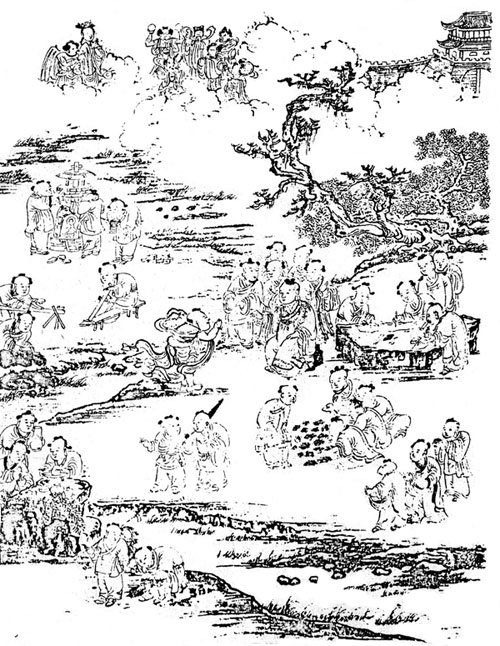THE GOOD KNOWING ONE
-By Bhiksu Heng Shun
-Edited by Bhiksu Heng Kuan

In the last chapter of the Flower Adornment Sutra (Skt. Avatamsaka), entitled "Entering the Dharma Realm" the youth named Good Wealth visits 53 teachers. Good Knowing Ones, in succession in his quest for enlightenment. Each Good Knowing One represents a level of spiritual attainment, and each one instructs him to visit the succeeding Good Knowing One. The following is an excerpt from part six (the sixth chuan), after Good Wealth visits the 12th Good Knowing One, the youth Abiding in Freedom and Ease. It is an eloquent expression of the wondrous qualities and benefits derived from meeting with the teaching of a Good Knowing One.
At that time the youth Good Wealth contemplated and considered thus, "The teaching of the Good Knowing One is like the ocean, which can receive the rain from a great cloud without becoming full." He thought, "The teaching of the Good Knowing One is like the sun in the springtime, causing all good dharma1 sprouts and roots to flourish. The teaching of the Good Knowing One is like the full moon, all that it shines upon is caused to be pure and cool. The teaching of the Good Knowing One is like a fragrant pool in the daytime, causing all the lotus flowers of the good heart to blossom. The teaching of the Good Knowing One is like a great treasure island, filling my mind with all kinds of Dharma jewels. The teaching of the Good Knowing One is like the Jambu tree, accumulating the flowers and fruit of all blessings and wisdom. The teaching of the Good Knowing One is like a great dragon king traveling about in space with freedom and ease. The teaching of the Good Knowing One is like Sumeru Mountain, on which the immeasurable good dharmas of the Heaven of Thirty-three abide. The teaching of the Good Knowing One is like the assembly surrounding the heavenly lord Sakra, whose splendor obscures and is able to quell the multitudes of asuras, who follow heterodox paths.
The Flower Adornment Sutra is known as the king of kings among Buddhist Sutras because of its great length (81 chuan, over 700,000 Chinese characters) and its extreme profundity, containing the most complete explanation of the Buddha's state and the spiritual path to enlightenment. The Buddhist Text Translation Society is presently working on a translation of the entire text of this Sutra into English, the first such comprehensive work. The text of the Sutra is accompanied by the extensive interlinear commentary of the Venerable Master Hsuan Hua, who is presently finishing his public lecture series (to date over 2,500 lectures) on this Sutra at the City of Ten Thousand Buddhas in Mendocino County, California. The lecture series began with the renowned verse and prose preface to the Flower Adornment Sutra by T'ang Dynasty National Master Ch'ing Liang. The entire translation work including the Sutra text, the preface and prologue, and the commentary to them all, is expected to be more than 150 volumes when completed. The first volumes are scheduled to be published by the end of this year.
1. Dharma the Buddha's teaching, especially the methods he taught to purify the mind so it becomes awakened.
2. Jambu tree rose apple tree (from Soothill's Dictionary of Chinese Buddhist Terms)
3. Sumeru Mountain lit. "Wonderfully High" Mountain, is at the center of every world system and is shaped like an upside down four-sided pyramid. It is many times greater than our sun, which abides near its summit. It can only be perceived by our heavenly eye.
4. Shakra--the chief god in the Heaven of Thirty-three (see footnote 5).
5. Heaven of Thirty-three--Of the 28 heavens, it is the next to lowest. It has eight heavens in each of the four directions and one in the middle. All these heavens are located on the summit of Sumeru Mountain. The chief god of this heaven, Sakra, dwells in the center heaven. All the gods here delight in much refined pleasure which far exceeds the bliss found in our human realm. Existence here is also apart from the sufferings of our earthly life. In this heaven, one day and one night is equivalent to 100 earth-years. The lifespan of the gods here is 1,000 of these heaven years.
6. Asuras--the ones referred to here are beings who have the blessings of gods but not their authority. They dwell in the ocean north of Sumeru or in the western Vajra Mountains. They are fond of fighting and often make battles with the gods of the Heaven of Thirty-three. The male asuras are said to be extremely, ugly while the Female asuras are very beautiful.